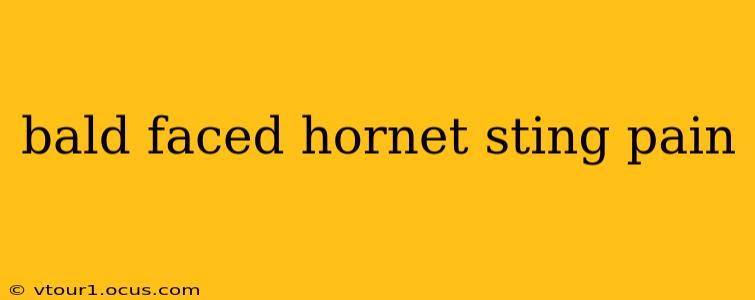The bald-faced hornet ( Dolichovespula maculata) is a common stinging insect in North America, known for its aggressive nature and potent sting. Understanding the pain associated with a bald-faced hornet sting, along with preventative measures and treatment options, is crucial for anyone living in areas where these insects reside. This comprehensive guide will delve into the specifics of a bald-faced hornet sting, addressing common questions and concerns.
How Painful is a Bald-Faced Hornet Sting?
The pain of a bald-faced hornet sting is often described as intense, sharp, and burning. Its severity can vary depending on individual sensitivity, the number of stings received, and the location of the sting. Many compare the pain to a wasp sting, but some describe it as more severe and longer-lasting. The Schmidt Sting Pain Index, a widely recognized pain scale for insect stings, rates the bald-faced hornet sting a 2.0 out of 4.0, placing it in the mid-range of insect sting pain. This means it's certainly noticeable and unpleasant, but not as excruciating as some other insects' stings.
What Does a Bald-Faced Hornet Sting Feel Like?
The initial sensation is a sharp, piercing pain at the sting site. This is quickly followed by a burning sensation that can spread slightly beyond the immediate area. Swelling, redness, and itching are common symptoms that develop within minutes to hours. The pain typically lasts for several hours, although the swelling and itching may persist for a day or two. The intensity of these symptoms can vary significantly from person to person.
How Long Does a Bald-Faced Hornet Sting Hurt?
The pain from a single bald-faced hornet sting usually subsides within a few hours. However, swelling and itching can linger for up to 48 hours. Multiple stings, or stings in sensitive areas, can prolong the discomfort. If pain persists beyond a day or two, or if you experience systemic symptoms (discussed below), seek immediate medical attention.
What are the Symptoms of a Bald-Faced Hornet Sting?
Besides the immediate pain, burning, swelling, and itching, other symptoms can include:
- Redness and inflammation: The stung area will become red and inflamed.
- Local swelling: Swelling can range from minor to significant, depending on the individual's reaction.
- Itching: Intense itching is a common symptom that can last for several hours or even days.
- Headache: In some cases, a headache can accompany a sting, especially with multiple stings.
- Fever and chills: These systemic symptoms indicate a more severe reaction and require medical attention.
- Difficulty breathing: This is a serious symptom indicating a possible allergic reaction and requires immediate emergency medical care.
- Nausea and vomiting: These symptoms can accompany a severe allergic reaction.
- Dizziness: Dizziness or lightheadedness may also occur in severe cases.
What Should You Do if You Get Stung by a Bald-Faced Hornet?
Immediate action is key when stung by a bald-faced hornet:
- Remove the stinger (if present): Unlike honeybees, bald-faced hornets don't leave their stinger behind. However, remove any visible fragments carefully with tweezers.
- Clean the area: Wash the sting site with soap and water to remove any remaining venom.
- Apply a cold compress: This will help reduce swelling and pain.
- Over-the-counter pain relief: Take ibuprofen or acetaminophen to manage pain and inflammation.
- Hydrocortisone cream: Apply a hydrocortisone cream to reduce itching.
- Monitor for allergic reactions: Watch for any signs of a severe allergic reaction (difficulty breathing, swelling of the face or throat, dizziness, nausea). If any of these symptoms appear, seek immediate medical attention.
Are Bald-Faced Hornet Stings Dangerous?
For most people, a bald-faced hornet sting is painful but not dangerous. However, individuals with allergies to insect stings can experience a severe, life-threatening reaction known as anaphylaxis. Symptoms of anaphylaxis include difficulty breathing, swelling of the face or throat, and a rapid drop in blood pressure. If you suspect an allergic reaction, seek immediate medical attention – this is a medical emergency.
How to Avoid Bald-Faced Hornet Stings
Preventing stings is always the best approach. Here are some tips:
- Avoid their nests: Bald-faced hornets are fiercely protective of their nests. Keep a safe distance and avoid disturbing them.
- Wear light-colored clothing: Dark clothing can attract hornets.
- Avoid sweet-smelling perfumes and lotions: These scents can attract hornets.
- Keep food and drinks covered: Hornets are attracted to the smell of sweet substances.
- Be cautious when mowing or gardening: These activities can disturb hornet nests.
This guide offers a comprehensive overview of bald-faced hornet stings, from the pain and symptoms to prevention and treatment. Remember, while most stings are manageable, it's crucial to be aware of the potential for severe allergic reactions and seek medical attention if necessary. Staying informed and practicing preventative measures is the best way to minimize your risk.
